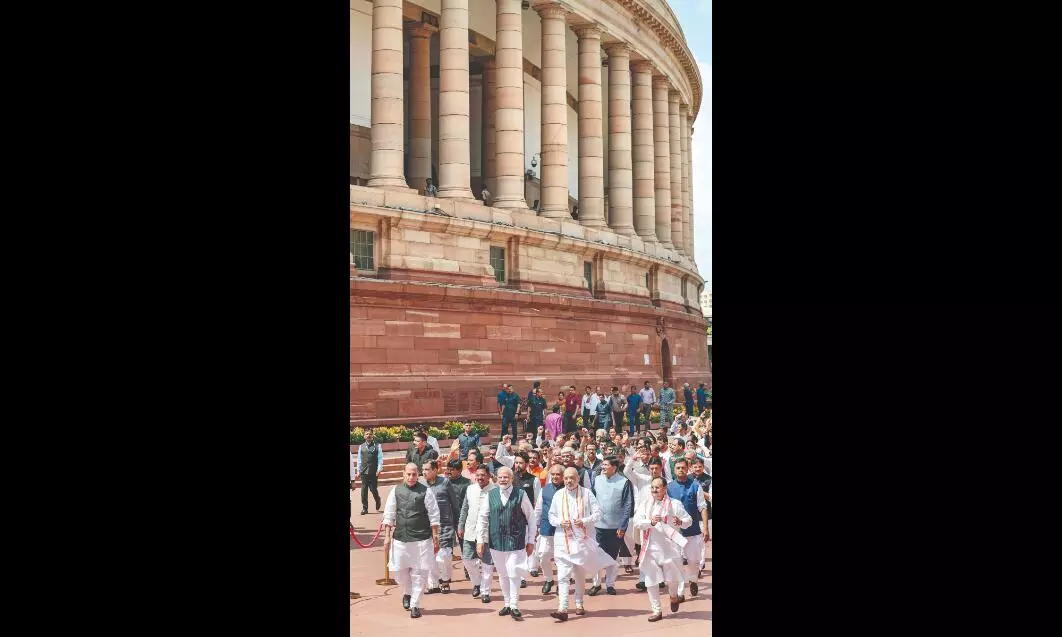Centre introduces Women’s Reservation Bill in Lok Sabha

New Delhi: The government on Tuesday tabled the much-awaited Women’s Reservation Bill in Lok Sabha.
The Nari Shakti Vandan Adhiniyam, 2023, earlier known as Constitution (One Hundred and Twenty Eighth Amendment) Bill, 2008, is the first Bill introduced in the new Parliament building. The new Parliament building has been designated as the Parliament House of India.
The Bill will come into effect only after the delimitation exercise is undertaken that is expected to be held after 2026 and will continue for 15 years.
Moreover, there are apprehensions among Opposition parties that the high-profile seats may be reserved for women in the upcoming Lok Sabha polls.
The Bill, which was introduced by Union Law Minister Arjun Ram Meghwal, is aimed at providing one third reservations to women and once the Bill would be passed by both the Houses of the Parliament, 181 seats would be reserved for women in Lok Sabha. The Bill, once cleared by Parliament, will have to get passed by every state Legislative Assembly.
As per the business list, the discussion on women’s Bill is scheduled to be held in Lok Sabha on Wednesday – the third day of the special session. As the Bill was introduced in Lok Sabha by the Law Minister, the Opposition members protested against introducing the Bill without distributing a copy of the Bill to Opposition members.
However, Parliamentary Affairs Minister Pralhad Joshi defended the move by saying that the Bill has already been uploaded on the portal and it’s available on the tabs provided to all members.
Notably, the Bill was passed in the Rajya Sabha in 2010 but was stalled in the Lok Sabha. The 2008 Bill sought to reserve one-third of all seats in Parliament and state assemblies for women.
As per the Bill’s statement of purpose, the government noted that women participate substantively in panchayats, municipal bodies, yet their representation in state assemblies and Parliament is still limited. Role of women is extremely important for achieving the goal of making India a developed country by 2047.
The Bill document further stated that seats reserved for women will be rotated after each delimitation exercise.
The Bill document further stated that a third of seats in Lok Sabha and assemblies will be reserved for women and filled by direct election. Within the quota, a third of the seats will be for Scheduled Castes and Scheduled Tribes. However, nothing has been clearly mentioned about the Other Backward Castes (OBC).
The issue of Women’s Reservation Bill first surfaced in 1996 when efforts were taken to introduce the Bill in the Lok Sabha and State Legislative Assemblies. The Bill didn’t receive enough support from regional parties that have stalled its passage in the last three decades.
In the 1990s, Rashtriya Janata Dal (RJD), Samajwadi Party (SP), Janata Dal (United), and Bahujan Samajwadi Party (BSP) majorly rallied against the proposal.
In the present scenario, BSP and JDU have decided to support the Bill. On the issue, BSP chief Mayawati said that her party will support the Bill even if the party’s demand for a quota within the quota for the SC, ST and OBC is not met.
Additionally, the data shows that women MPs account for nearly 15 percent of the lower House’s strength while their representation is below 10 percent in many state assemblies.
In the present Lok Sabha, 82 women members were elected which account for less than 15 percent of the total strength of 543, while in Rajya Sabha too, women’s representation is about 14 percent.
Several state assemblies have less than 10 percent women representation, including Andhra Pradesh, Arunachal Pradesh, Assam, Goa, Gujarat, Himachal Pradesh, Karnataka, Kerala, Madhya Pradesh, Maharashtra, Manipur, Meghalaya, Odisha, Sikkim, Tamil Nadu, Telangana, Tripura and Puducherry.
Bihar, Haryana, Punjab, Rajasthan, Uttrakhand, Uttar Pradesh and Delhi had 10-12 percent women MLAs, according to the government data of December 2022.
Chattisgarh, West Bengal and Jharkhand led the charts with 14.44 percent, 13.7 percent and 12.35 percent women MLAs, respectively.
In the last few weeks, several parties, including the BJD and the BRS have demanded reviving the Bill, while Congress also passed a resolution at its Hyderabad Congress Working Committee meeting on Sunday.
The 2008 Bill, which was passed in Rajya Sabha in 2010 before it lapsed following the dissolution of Lok Sabha, also proposed reserving one-third of all seats in Lok Sabha and legislative assemblies in each state for women. The UPA was in power when the last attempt was made to pass the Bill.
Before the failed attempt of 2008-2010, a similar Bill was introduced in 1996, 1998 and 1999.



